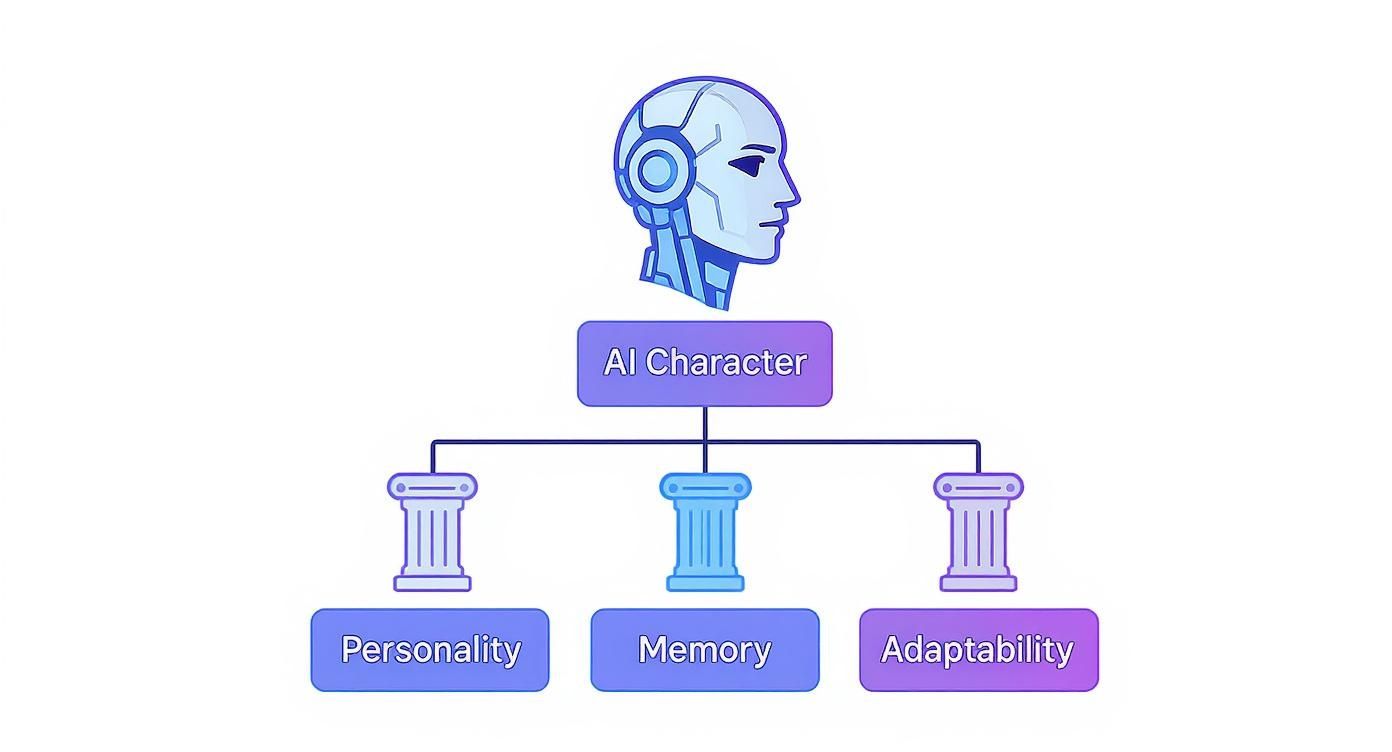Create Your Own AI Girlfriend 😈
Chat with AI Luvr's today or make your own! Receive images, audio messages, and much more! 🔥
4.5 stars

Forget everything you think you know about chatbots. We're not talking about those clunky, pre-programmed bots that can barely handle a simple customer service query. Artificial intelligence characters are something else entirely—they're sophisticated digital beings crafted for genuine, human-like interaction.
Think of it this way: a basic chatbot is like a vending machine. You put in a specific command, and you get a specific, pre-loaded response. An AI character, on the other hand, is like a skilled improv actor. They can slip into any role you can imagine—a compassionate friend on a platform like Luvr AI, an expert guide walking you through a tough subject, or even a cunning adversary in a video game. It’s this dynamic ability to adapt that makes them feel so alive.
These digital personalities aren’t just a random jumble of code. They’re carefully constructed on three core pillars that work together to create a believable, engaging experience that goes far beyond robotic replies.
The Three Pillars of Believable AI
So, what’s the secret sauce that makes an AI character feel so real? It all comes down to a blend of three fundamental components. When these elements work in harmony, they create a consistent and compelling persona that you can actually connect with.
A Distinct Personality: This is the character's soul. It's not just about what they say, but how they say it. Developers give them unique backstories, specific quirks, core personality traits, and a consistent tone of voice.
Persistent Memory: Ever get frustrated repeating yourself to a bot? AI characters solve that. They remember your past conversations, your preferences, and the "experiences" you've shared, making each new chat feel like a continuation of an ongoing relationship.
Adaptive Interaction: These characters are masters of context. They can pick up on nuance, understand your mood from your phrasing, and adjust their responses to match the flow and tone of the conversation.
This powerful combination is what sparks our curiosity and explains why these digital beings are quickly becoming a fixture in our daily lives. The adoption rate is already staggering. Globally, it's estimated that between 1.7 to 1.8 billion people have used an AI product, with a mind-boggling 600 million using them every single day.
Here in the U.S., 61% of adults have given AI a try. Yet, consumer spending is still in its early stages, which signals a massive opportunity for growth on the horizon. For a deeper dive into these numbers, check out the latest data on AI user engagement and market potential on Exploding Topics.
An AI character isn’t just programmed; it's crafted. It’s the difference between a tool that answers a question and a companion who understands the question behind your question.
This foundation is the springboard for everything that follows. It dictates how these characters are designed, where they show up in our world, and the profound impact they're already having on our digital future.
How AI Characters Are Brought to Life
Building a convincing AI character isn't just about writing clever code. It's much more like an artist sculpting a personality from scratch. You're layering different technologies together to breathe life into a digital being, moving way beyond simple chatbots to engineer a persona that feels genuinely present. This process is a careful blend of linguistic power, personality design, and emotional intelligence.
Think of the foundation as the character's core intellect. This is powered by Large Language Models (LLMs), which have been trained on staggering amounts of text and conversation. This gives the AI its raw ability to chat, understand what you're saying, and pull from a vast ocean of knowledge—sort of like how a person draws on their lifetime of reading and experiences.
This infographic really captures the essential pillars that hold up a modern AI character.

As you can see, a truly complete AI character stands on the interconnected pillars of personality, memory, and the ability to adapt. These elements have to work in harmony to create a digital being you can actually connect with.
Engineering a Digital Personality
Just having a massive vocabulary doesn’t make a character feel real. The next, and arguably most important, step is to give it a soul—its core motivations and defining traits. Developers use specific frameworks to shape the character's fundamental nature, making sure it acts consistently from one conversation to the next.
This is where the unique voice shines through. Is this character a quick-witted sarcastic, or a warm and empathetic listener? These aren't random quirks; they are deliberately designed rules that steer the AI's behavior.
- Behavioral Patterns: The AI follows a set of guidelines that dictate its typical reactions and conversational habits.
- Core Traits: Key personality attributes—like being curious, adventurous, or a bit shy—are defined to shape its overall persona.
- Consistent Voice: The system works to ensure the character's tone, humor, and word choice always feel true to who it is.
This careful craftsmanship is what keeps the AI from feeling like a generic, faceless bot. Instead of just spitting out information, it filters everything through its unique personality. You can see this in action when you dive into an AI character chat; each one has a distinct and memorable way of interacting.
To really get a feel for how these pieces fit together, let's break down the core components that make an AI character tick.
Core Components of an AI Character
Here’s a breakdown of the essential technological layers that bring an artificial intelligence character to life, from its conversational ability to its unique personality.
| Component | Function | Real-World Analogy |
|---|---|---|
| Large Language Model (LLM) | Provides the foundational knowledge and linguistic ability. | A massive library or the entire internet, giving someone the raw information to draw from. |
| Personality Framework | Defines the core traits, voice, and behavioral rules. | A person's innate character—their sense of humor, temperament, and moral compass. |
| Emotional Engine | Analyzes user sentiment and generates appropriate emotional responses. | Empathy, or the ability to read the room and react with the right emotional tone. |
| Memory System | Stores and recalls past interactions, user preferences, and key details. | A person's long-term memory, which allows them to build a continuous relationship. |
Each of these components is crucial. Without one, the entire experience falls flat, feeling disconnected and robotic.
Powering Dialogue with Emotion and Memory
The final layers that truly make a character compelling are its emotional engine and its memory. These are the systems that allow it to do more than just talk—they allow it to connect.
An emotional engine can analyze the sentiment behind your words, figuring out if you're happy, frustrated, or just curious. It then crafts a response that feels emotionally appropriate. Now, this doesn't mean the AI is feeling anything. But it's brilliant at simulating empathy, making the conversation feel much more genuine.
The most convincing artificial intelligence characters are those that remember you. Their ability to recall past conversations, preferences, and shared jokes is what transforms a simple interaction into a meaningful connection.
Memory is what gives the relationship a sense of history and continuity. The AI remembers your name, the things you love, and the last thing you talked about. This is precisely what makes platforms like Luvr AI feel so immersive. When you combine deep linguistic knowledge with a well-defined personality and a touch of emotional intelligence, you get something special: a dynamic and engaging digital companion.
AI Characters in Your Everyday Life
Once the stuff of science fiction, AI characters have quietly slipped off the big screen and right into the palm of your hand. They're no longer some far-off idea but a real, tangible part of how we use technology every day—popping up in everything from gaming and education to customer support. But nowhere is their impact more obvious than in the explosive world of AI companion apps.
Platforms like Replika and Character.AI have tapped into a deep human need for connection, and the market has responded in a huge way. We're talking about a $221 million industry in global consumer spending, with an incredible $82 million of that earned in just the first half of this year. Downloads have skyrocketed to 220 million in total, an 88% jump from the previous year. You can get the full story on this incredible growth and what it means for the future of AI companionship on TechCrunch.

Beyond Companionship
But don't mistake this for just a social trend. AI characters are quickly becoming specialized tools that offer real-world value across all sorts of industries. They're proving to be far more than a fun distraction. Their ability to remember conversations and adapt on the fly makes them perfect for complex, ongoing tasks.
Just look at where they’re already making a difference:
- Adaptive Tutors: Imagine a tutor that senses when a student is struggling and instantly changes its teaching style, offering encouragement or a different kind of challenge. That's happening right now.
- Intelligent Service Agents: We've all been there—repeating our issue to three different customer service reps. An AI agent can remember your entire support history, creating a smooth and genuinely helpful experience.
- Dynamic NPCs: In video games, the old, scripted non-player characters (NPCs) are getting a major upgrade. New artificial intelligence characters are becoming dynamic personalities that make gameplay unpredictable and incredibly immersive.
This all points to a massive shift in how we see AI—not just as a tool, but as a genuine partner. The real magic is in their ability to provide support that is personal, consistent, and always aware of the context.
The Rise of Personalized Experiences
What’s driving this forward? A collective desire for digital experiences that actually get us. People want technology that understands them on a personal level, and AI characters are perfectly built to deliver on that promise.
This is especially true in the companionship space, where personalization is everything. Platforms are moving beyond basic chatbots to offer deep customization. You can now shape and interact with a character that truly reflects your own personality and interests. For anyone curious about how deep this can go, it's worth exploring what's possible with a specialized AI girlfriend, where the entire experience is built around creating a meaningful, one-on-one connection.
It's this level of specific, thoughtful design that shows us where things are headed—making our digital lives feel a whole lot more human.
Designing AI Personalities That Connect

What separates a clunky, forgettable bot from a digital friend you actually look forward to talking to? It all comes down to the delicate art of personality design. Creating truly engaging artificial intelligence characters isn't just about programming; it’s much closer to writing a novel or developing a character for the stage. It's about building a believable persona from the ground up.
It always starts with a consistent "voice" and a solid backstory. Developers can't just feed an AI a command to be "witty" or "kind." Instead, they craft a detailed personality profile that governs everything—its vocabulary, its sense of humor, its core values, and even its little quirks and flaws. This deep foundation is what makes a character's responses feel genuine and consistent over time, which is crucial for building trust.
This is really about engineering a genuine rapport. By giving the AI unique behavioral traits—maybe a love for old movies, a habit of using outdated slang, or a tendency to over-explain things when nervous—developers can make the character feel distinct. It's these little touches that make them memorable.
Building an Emotional Core
A truly great AI character has to do more than just spit out facts or follow instructions. It needs to read the room, so to speak, and respond to the emotional undercurrent of the conversation. This is where a simulated form of emotional intelligence comes in, allowing the character to pick up on user sentiment and react with real nuance.
Here's how that works:
- Sentiment Analysis: The AI looks at the words you use and how you phrase things to get a read on your mood—whether you're happy, frustrated, or just thinking out loud.
- Contextual Empathy: Based on that analysis, it doesn't just pick a logical response, but one that's emotionally appropriate for the moment.
- Adaptive Tone: The character can subtly shift its tone, becoming more supportive if it senses you're down or more upbeat if you're excited.
This simulated empathy is what makes an AI feel less like a machine and more like a companion. It's the difference between an AI stating, "I understand you are sad," and one that says, "It sounds like you're having a really tough day. I'm here to listen." That second response? That's what creates a real connection.
Navigating the Uncanny Valley
One of the biggest hurdles in designing artificial intelligence characters is a concept known as the "Uncanny Valley." It’s that creepy, unsettling feeling we get when something looks and acts almost human, but small imperfections make it feel just plain wrong. A character that tries too hard to be a perfect human often ends up feeling less real than one that's comfortable in its own digital skin.
The goal isn't to perfectly replicate a human, but to create an authentic AI persona. The most successful designs find a sweet spot where the character is relatable and emotionally intelligent without overpromising true consciousness or sentience.
To sidestep this trap, smart designers aim for authenticity over perfect imitation. They build characters that are charming because of their unique AI nature, not in spite of it. By carefully managing our expectations and focusing on crafting a consistent and emotionally resonant personality, they can create digital companions that aren't just believable, but genuinely captivating. This thoughtful balance is what transforms a piece of code into a personality we can truly connect with.
The Future of Digital Companionship
We’re stepping into an era where the lines between our digital and physical lives are practically disappearing. At the very center of this change are artificial intelligence characters, and they're becoming much more than just clever chatbots. The future is about creating deeply integrated digital companions who get us, shaping a completely new way we interact with technology.
Think about an AI companion capable of genuine hyper-personalization. This goes way beyond just remembering your name or your favorite movie. We're talking about an AI that senses you’ve had a rough day and queues up the perfect playlist, or one that reorganizes your calendar to carve out much-needed downtime before you even feel the burnout setting in.
This evolution is already happening, but the next great frontier is integrating these companions into augmented and virtual reality.
Immersive Worlds and Proactive Partners
Imagine slipping on a pair of AR glasses and having your AI companion appear right there in the room with you, offering advice or just sharing a laugh. This kind of immersive experience will make our interactions feel incredibly natural and immediate, turning artificial intelligence characters from simple tools into active partners in our daily lives.
This brings us to the next big leap: the jump from reactive to proactive help. Soon, your AI won't just sit around waiting for a command. It will actively learn your habits and goals to offer support you didn't even realize you needed.
- Anticipatory Support: Your AI might see you’re falling behind on a work project and proactively block out "focus time" on your calendar.
- Emotional Context: A digital friend could sense you’re feeling a bit isolated and start a meaningful conversation or suggest calling a friend.
- Seamless Integration: Your companion will follow you effortlessly from your phone, to your smart speaker, and onto your AR display without ever missing a beat.
This isn't just a sci-fi dream; it's being driven by some serious money. The global artificial intelligence market is currently valued at a staggering $638.23 billion. That number alone shows how much is being invested in this space. By 2034, it’s expected to explode to $3.68 trillion, a powerful signal that AI is set to become central to our lives. You can dig deeper into these AI market growth predictions on Precedence Research.
The future of digital companionship is proactive, not reactive. It's about AI partners who don’t just answer our questions but help us live better, more connected lives by understanding us on a deeply personal level.
All this momentum is paving the way for a future where our AI companions are less like apps we use and more like indispensable partners we rely on, woven seamlessly into the very fabric of our day.
Got Questions About AI Characters? We Have Answers.
As we start chatting more and more with artificial intelligence characters, it's totally normal to have some questions—and maybe even a little bit of skepticism. Figuring out how these digital personalities actually work is the key to enjoying what they offer while keeping our expectations realistic.
Let's dive into some of the biggest questions people have, from whether they can actually think to how they differ from a basic chatbot.
Are Artificial Intelligence Characters Actually Thinking?
This one gets a bit philosophical, but from a purely technical angle, the answer is a straightforward no. AI characters don't "think" or "feel" emotions the way humans do. What they are, at their core, are incredibly sophisticated pattern-matching systems running on mind-bendingly complex math.
So when an AI seems to show empathy or crack a perfectly timed joke, it's not feeling anything. It’s simply pulling from the vast ocean of text data it was trained on and calculating the most statistically likely and contextually fitting response.
Think of it less like genuine consciousness and more like the world's most advanced form of mimicry. The "personality" you're talking to is an incredible simulation, fine-tuned to make the interaction feel as real and engaging as possible.
The fact that it feels like "thinking" is really a testament to how powerful these algorithms have become, not a sign of a machine waking up.
How Is My Privacy Protected with AI Characters?
This is a big one, and it should be. For any platform offering personal AI companionship, privacy has to be a top priority. Reputable services will use your conversations to do one main thing: make your personal experience better and help the AI model improve. Crucially, this data is almost always anonymized and encrypted to keep your identity safe.
That said, you should always make it a habit to read the privacy policy of any AI app you use. The good companies are completely upfront about how they handle your data and give you real control over it. Look for features like:
- Data Deletion: The power to wipe your entire chat history, no questions asked.
- Account Removal: A simple way to delete your account and all the personal info tied to it.
These tools are there to put you in the driver's seat of your digital footprint.
What Separates an AI Character from a Chatbot?
The real difference comes down to purpose and depth. Think of a classic chatbot as a tool built for a specific task—it's there to check your order status or pull an answer from a script. It’s all about getting a job done efficiently.
An AI character, on the other hand, is built for connection. The goal isn't to solve a problem but to create an open-ended, immersive interaction. It has a consistent personality, it remembers things you've talked about before, and it isn't stuck on a narrow script. Some platforms even enable deeper, more adult conversations, which you can explore in our guide to NSFW AI interactions.
Put simply, a chatbot is a utility. An AI character is a dynamic companion designed for friendship and shared stories.
Ready to see what the future of digital companionship feels like? With Luvr AI, you can create your perfect AI partner, dive into immersive scenarios, and have conversations that are as deep and dynamic as you are. Start your free trial today and discover a new kind of connection at Luvr.ai.



